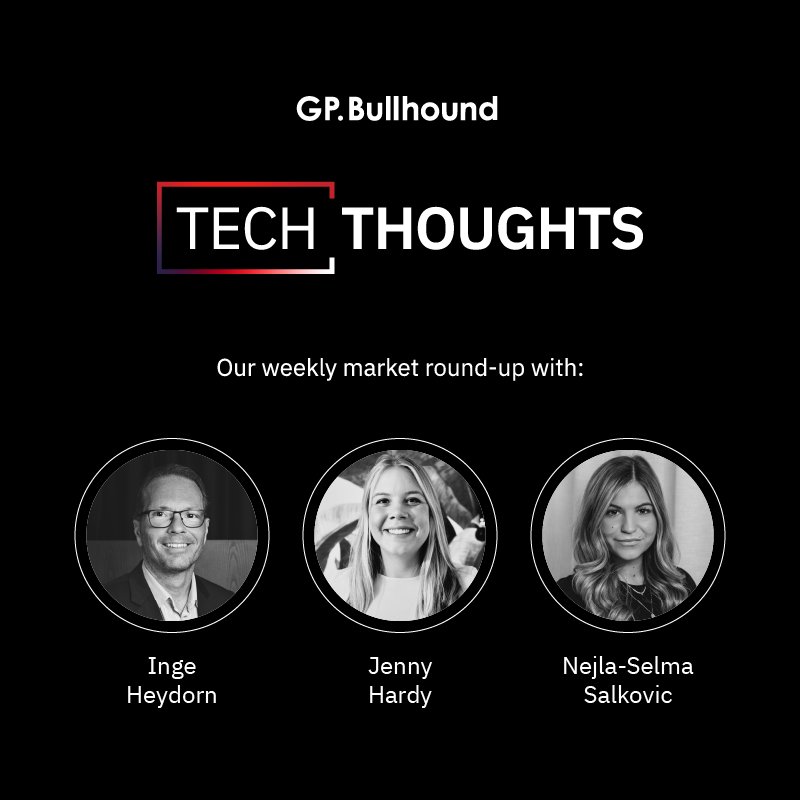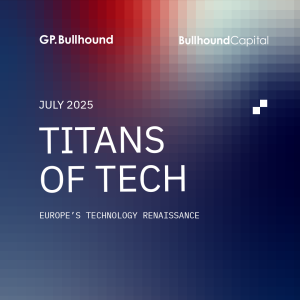Tech Thoughts Newsletter – 6 October 2023.

Market: September’s mixed mood has spilt into the first week of October – the market continues to be volatile, with “too hot” job data in the US this week hurting tech. We’re awaiting payroll data today and inflation next week. There’s no getting away from tech being correlated around rate expectations in the short term, but Q3 earnings (which kick off in a couple of weeks) will hopefully start to see share prices driven by fundamentals and earnings resilience (which we think the companies in the portfolio will show).
Portfolio: We made no major changes to the portfolio this week.
US/China export rules back into focus
- This week, export restrictions are back in focus as Reuters reported that the Biden administration has pre-emptively warned China of its plans to update the restrictions on shipments of AI chips and advanced semicap equipment.
- The article discusses “closing loopholes” and limiting access to chipmaking tools in line with the Dutch and Japanese rules.
- In July, the Hague confirmed the new Dutch regulations around shipments of ASML’s immersion tools. It meant that 3 out of 4 of ASML’s immersion lithography systems are restricted, which makes it very hard for Chinese customers to build sub 28nm production at scale (we think it will still be possible to get to 7nm – like Huawei’s latest chip – but that this requires a lot of multiple patterning, which makes it hard to make sense economically – though that’s not to say that China won’t be trying).
- Notably, the 1980i immersion tool can still be ordered and shipped without a licence, and this can enable at-scale and economical production of 28nm, which is where we see ample opportunity for China, and makes up our still optimistic view of China continuing to order semicap equipment despite restrictions.
- Europe is also rumoured to implement bloc-wide export controls in sensitive technology – semiconductors, artificial intelligence, quantum computing and biotechnology.
Portfolio view: On semicap, while US export controls prevent China from receiving leading-edge machines, they can still receive equipment to build out trailing or more mature node technology. We believe it makes sense for China to try to build up a strategic position in trailing edge semis. The reality is that there is a structural supply shortage in trailing edge globally; these semis are critical (in autos, industrial) – that was brought by the deficit during the pandemic, and it is only TSMC who have meaningful supply outside of China (Global Foundries is still relatively small in terms of capacity). It’s also an area the US has, and continues to, ignore (even with the CHIPS act) after Intel sold off or reused most of its trailing edge fabs decades ago. China building up critical supply not only for its domestic demand but also for the needs of the US would put it in a reasonably powerful negotiating position.
China will continue to spend and significantly contribute to semicap equipment revenue for the next several years. We own ASML, LAM Research, Applied Materials and KLA.
On chips currently, the restrictions relate to the interconnect speed of chips. That is the speed at which you can move data into and out of the chip, which is essential when training AI models in data centres. Currently, Nvidia sells a special “slowed down” chip into China – amounting to ~$3bn shipments per quarter. It has yet to be determined whether the restrictions will be to reduce the speed of interconnect allowed for chips exported into China or a broader ban. A more general ban would be negative longer-term. Still, CEO Jensen Huang last quarter noted it would not have an immediate impact on sales because the current shortages are such that chips not sold in China would be sold elsewhere. There is some nuance here – the gross margins from China are likely higher than the rest of the world (given higher pricing), but the key is that it certainly wouldn’t mean $3bn of sales going away.
On the European rumours, the only European names in our portfolio are Infineon and ASML. ASML is already restricted in China (as per the semicap rules), and for Infineon, which does have a significant China presence (see further comments below), we see very little justification for limiting power semis (which have neither AI, nor specific military applications).
And semis subsidies are back
- More chip subsidy announcements this week (which go somewhat hand in hand with export restrictions in our view) – Japan is approving $1.3bn in subsidies for Micron’s Hiroshima factory, which will amount to ~40% of Micron’s investment plans in Japan.
- It also helps that DRAM and NAND memory spot prices are increasing significantly – a market dynamic that has in the past led to higher semicap spending. Memory pricing is incredibly cyclical; typically, in those periods of higher prices, you see memory manufacturers committing to more spend.
- STMicro is also rumoured to be building a €5bn SiC fab – presumably helped by EU subsidies – and is also rumoured to get up to 40% of the cost back.
Portfolio view: Governments worldwide have decided building and subsidising local fabs is a good idea. We’ve said before that, bar the geopolitical risk in Taiwan/China, it makes little sense. But semis and geopolitics continue to be intertwined. More localised fabs ultimately means more semicap equipment and remains one of the drivers of our above-consensus view on the space.
Slightly relatedly, Disco this week announced its preliminary July-September (calendar Q3) sales figures, 5% ahead of consensus and growing 17% qtr/qtr – the quarter-on-quarter guidance from all of the space (we own ASML, AMAT, LAM Research, KLA) is all for flat/single-digit sales growth, so Disco’s sales growth bodes well for a slightly better quarter – and we think memory spend in particular will help into the end of the year.
AI server shift and GPU shortages continue
- Dell (not owned) held its analyst day – most interesting for us were its comments on AI servers. We noted after its results that it had stated lead times for Nvidia GPUs were 39 weeks.
- Their comments this week: “Lead times are still 39 weeks… supply continues to improve and demand continues to outpace supply…” so, no change – Nvidia chips continue to be gated by supply.
Portfolio view: The AI server shift is happening, with Nvidia chips the key components everyone wants to get their hands on, still limited by supply. On stage, Dell management commented that they’re tracking alternative accelerator chips – both ARM and RISC-V, which isn’t a surprise, though we still think ARM adoption is a while away. The current shortages will bode well for AMD’s entry into the pure GPU market (its supply will start to ramp towards the end of the year) as a credible alternative to Nvidia (we own both Nvidia and AMD).
Taiwanese monthly numbers for September – all about the iPhone build
- TSMC’s (owned) September revenue was NT$180bn, down slightly (4%) mth/mth from August, but implying Q3 revenue of NT$546bn, which is a 3% beat vs consensus and implies 15% qtr/qtr growth (though still down 11% yr/yr).
- Hon Hai (not owned) September sales were back to the highest sales figures since January (which itself was elevated after the late 2022 Covid disruption) – up 60% month-on-month but still down 20% yr/yr – it still means relatively poor volume in what should have been a big ramping month for the iPhone. In that context, then, TSMC better sales are likely benefitting from Nvidia GPU demand filling in 7nm (A100) and 5nm (H100) demand.
- UMC (not owned) September sales are still hovering at NT$19bn, relatively stable month-on-month, though tracking 25% below year-ago levels. That speaks to the weaker PC and smartphone market.
- Largan (not owned) – the sole supplier for the iPhone 15 Pro Max periscope lens – sales also ramped – we think to an all-time monthly high number. The camera continues to be one of the standout features every year for the iPhone – and in the context of the usual commoditised smartphone suppliers, Largan continues to do a decent job of staying ahead of the competition.
Portfolio view: Stabilisation is good news, particularly amidst the weak smartphone (excluding Apple) end demand. TSMC 5nm capacity will still be filled by Nvidia H100 demand, as Apple shifts from 5nm to 3nm for its A17 chip. The implications of the ongoing iPhone 15 Pro overheating issues are unclear and something we’re watching closely (early reports overnight are that the software “fix” didn’t work – we noted last week that having an underperforming node can either result in a pull forward of capex, because TSMC may decide to jump more quickly to the next node, or it can equally push back mass production of a new node).
Google’s Pixel 8 brings Edge vs Cloud AI debate into focus
- Alphabet/Google (owned) held its Made by Google 2023 event.
- The main event was the new Pixel 8 smartphone, which featured the new Tensor G3 chipset – made by Samsung Foundry 4nm process.
- One of the most exciting ideas in the new product releases is that AI will run on the end device. The chipset includes the latest generation ARM CPUs, an upgraded GPU, a new ISP, Imaging DSP and Google’s own TPU, custom-designed to run Google’s AI models.
Portfolio view: We own Google, although its hardware product portfolio is a small part of the underlying returns in the business. The implications on the semiconductor side of running AI in end devices/at the edge are most interesting for us in the portfolio. We’ve spoken before that AI players will want to shift as much of the workload into edge compute and onto local hardware, and out of the central cloud – mostly to make it as cost-effective as possible.
There are also lots of reasons why AI players will not want to be tied into Nvidia in inference to the extent that they will inevitably be tied to them in training. Everyone is motivated to look for a credible alternative to Nvidia to avoid being tied to one very powerful supplier. Google is the most obviously progressed here with its TPU v4 and has the benefit of being able to optimise workloads on both the cloud and end devices (we can argue the same motivation exists for Amazon with its Home device products – we wrote about its Anthropic investment in last week’s letter).
China EV September numbers
- We had several automotive data points through this week – most significantly Chinese September/Q3 EV shipments.
- BYD, which is by far the world’s largest EV manufacturer if you include both battery and plug-in hybrid, has just about caught up with Tesla’s Battery EV volumes – it sold 431,603 fully electric vehicles in Q3 vs Tesla’s 435,059. It will almost certainly sell more than Tesla in Q4. Its total Q3 shipment volume was 822,094, backing out September at 285k vs August 274k and July 262k. It makes the 3m EV target for this year look reasonably achievable.
- While more minor, other Chinese brands also reported substantial September shipment numbers – Li Auto +212% yr/yr/, Nio +44% yr/yr, XPeng +81% yr/yr.
- We’ve said that China EV is the one bright spot in an otherwise very damp Chinese economic data this year – admittedly helped by continued market subsidies. China’s EV penetration is set to reach close to 40% by year-end and will lead the world in terms of moving away from combustion engine vehicles.
- Did we mention that Tesla cut prices again in the US this week?! The price war in EV continues.
Portfolio view: The EV shift and the increased semiconductor requirements in EV continue to be a critical exposure in the portfolio for us – we own Infineon and NXP, both of whom sell into BYD. We don’t own any auto OEMs – which will continue to see pricing pressure.
Infineon auto update call – long-term structural drivers and pricing power
- Infineon (owned) held an investor call this week with the president of their auto division, which we attended.
- We’ve spoken before about some of the long-term structural growth drivers at Infineon, around EV (which requires significantly more power semiconductor content), ADAS (more sensors) and, in general, the premiumisation of autos – all of which benefit Infineon.
- The total semiconductor content in a combustion engine vehicle is ~$750 vs. a BEV now of $1,300, and that is expected to go to $2,000 in 2030 given more complex drivetrains and SiC inverters (which increases the semis content).
- Some concerns last quarter around how sustainable the pricing was for Infineon, and therefore, the profitability. But the head of autos emphasised that the high levels (28% this year) are sustainable given long-term/multi-year price agreements, which has become a new industry feature.
- They did acknowledge local competition in China – and that’s the thing we need to watch the closest in the sector – it makes sense that China wants to meet the demands of its own massive and growing EV market. It’s also the part of the market that they can build for – going back to the semicap restrictions currently in place.
- An interesting data point: Infineon’s value in a high-end Chinese auto is more than €800 per car. If you do the maths on that for the 3m BYD autos, that’s €2.4bn. But we think the current China auto revenue of ~€2bn. It means that as the premiumisation story plays out in EV, the revenue growth potential for Infineon is significant. Auto OEMs are competing with content and features like the old smartphone world – it’s a multi-year driver for the semiconductor companies that supply to them (and, unlike smartphones, these suppliers are designed for seven-year cycles).
- It all means Infineon is expecting double-digit growth in their auto business next year, critically – assuming flat car production.
Portfolio view: We own Infineon and view it as the key beneficiary of the ongoing shift to EV – we consider this update reassuring in the context of broader market concerns around pricing and margins and believe they can beat quite conservative market expectations.

For enquiries, please contact:
Inge Heydorn, Partner, at inge.heydorn@gpbullhound.com
Jenny Hardy, Portfolio Manager, at jenny.hardy@gpbullhound.com
Nejla-Selma Salkovic, Analyst, at nejla-selma.salkovic@gpbullhound.com
About GP Bullhound
GP Bullhound is a leading technology advisory and investment firm, providing transaction advice and capital to the world’s best entrepreneurs and founders. Founded in 1999 in London and Menlo Park, the firm today has 14 offices spanning Europe, the US and Asia.



